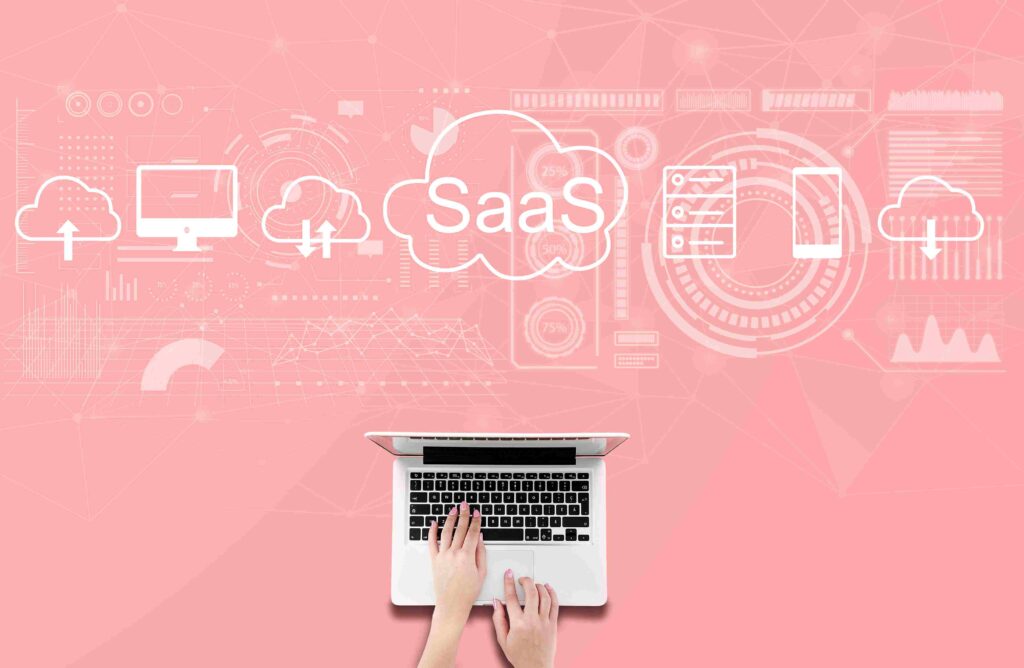Lately, software as a service has emerged as a favored business model among many enterprises.
Startups and tech firms can achieve meaningful revenue increases through creating a thriving SaaS product. To generate profits in the SaaS sector requires a detailed strategy along with a thorough comprehension of user desires.
This comprehensive guide covers key steps and considerations in SaaS product development, from the initial business case to launch and beyond.
Understanding the SaaS Business Model
Before diving into development, it’s important to understand what makes the SaaS model unique.
Key Characteristics of SaaS
- Software is centrally hosted. Customers access the application over the internet, rather than installing software locally. This eliminates the need for downloads, updates etc.
- Customers subscribe to the software. Rather than a one-time license fee, customers pay a recurring subscription, usually monthly or yearly. This provides stable, recurring revenue.
- Applications are multi-tenant. One model of the application supports various users. Each user retrieves individual data with a common code structure.
- Usage is scalable. Businesses can readily grow their software’s capacity by expanding storage and bandwidth. The cloud-based service allows for resource tuning.
Benefits of SaaS
The SaaS model offers advantages for both vendors and users:
For Vendors:
- Consistent revenues that repeat regularly.
- Potential for faster growth.
- Lower distribution costs.
- Increased understanding of customer behavior from data collected on usage.
For Users:
- Customers eliminate the need for hardware/software installation or storage.
- Connectivity is available from any device with online presence.
- Capacity to tailor usage in response to different demands.
- Central deployment features and updates introduce fresh capabilities.
Developing a SaaS Product Roadmap

Source: freepik.com
Prior to creating any code at all is essential to establish a comprehensive product plan that mirrors the company’s main objectives.
Start with the Target Customer
Establish the segments that the SaaS product software will serve. Form user identities that mirror real-life positions and dilemmas the software targets. Common SaaS personas may include:
- Deadline crunchers searching for easy workflows.
- People in distributed workplaces require tools for teamwork.
- Remote employees rely on mobile technology.
- On-premise infrastructure is managed by IT professionals.
Identify Must-Have Features
Prioritize 3-5 “must-have” features or functions that directly address core customer needs and will drive initial product adoption. These should anchor the first product release.
Examples:
- Task management with shared status visibility.
- Mobile forms for field data capture.
- Basic dashboard and reporting.
Map Future Enhancements
Outline additional features, integrations and capabilities for subsequent releases. These provide a path for continuous expansion after the initial launch. Examples:
- Expanded analytics and business intelligence.
- Role-based access controls.
- Automation and AI recommendations.
Architecting Scalable SaaS Solutions
A critical step is architecting backend infrastructure and systems to support reliability at scale. Key elements include:
- Multi-Tenant Architecture. The software must handle multiple tenants sharing compute resources without interruption. Segregate tenant data while running core functions from a shared code base.
- Elastic Scalability. Automate expansion of server capacity to handle spikes in usage. Cloud infrastructure makes this readily achievable.
- High Availability. Ensure 24/7 software availability, avoiding any single point of failure. Use redundant infrastructure across multiple geographic regions.
- Ongoing Maintenance. Plan automated testing and systems to push updates without downtime. Support rapid iteration without disruption.
Integrating Cutting-Edge SaaS Technology
Leverage modern frameworks, services and tools to accelerate development and innovation:
- Cloud Native Development. Build for cloud platforms from day one for maximum scalability and efficiency.
- Containers and Microservices. Break software into independent components that can be updated frequently.
- APIs. Open APIs enable seamless connectivity with other products and custom extensions.
- Continuous Delivery. Automate testing and releases to improve quality and deploy innovations faster.

Source: ScienceOpen.com
Creating Intuitive and Engaging User Experiences
While architecture might not be visible to users, the UI and UX design plays a pivotal role in adoption, retention and growth.
- Responsive Design. With growing mobile usage, SaaS apps must provide excellent responsive experiences across all devices.
- Intuitive Navigation. Guide users with clear and consistent information hierarchy, navigation menus and calls to action.
- Frictionless Workflows. Streamline complex processes into easy-to-use, automated workflows tailored to the user’s context.
- Personalization. Allow customization for individual preferences and usage patterns.
Driving SaaS Growth with Customer-Centric Strategies
Entrepreneurs require a careful blend of fresh initiatives and addressing true client requirements. Different methods can promote organic expansion through the continuous involvement of clients.
- Onboarding and Education. Teach important tasks to newcomers during their initial phases. Give users advice and education in-app when they need it.
- Customer Feedback Channels. Collect opinions from clients by asking for responses on support tickets and community interactions. Recognize the foremost challenges and development possibilities.
- Tiered Pricing Plans. Establish cost levels that accord to the benefits provided. As client use increases, their progression leads to premium options with extra functionality.
- Integrated Analytics. Use in-built analytics to reveal usage patterns. Set KPIs that point out the risk of churn or potential for upselling. Inform users at the right time.
Launching an MVP for Market Validation
Rather than attempting to build a fully featured product upfront, agile SaaS product startups launch a minimum viable product (MVP) to validate market demand.
- Define Success Metrics. Outline key benchmarks for users, revenue and market impact to gauge performance.
- Instrument Analytics. Incorporate event tracking to measure usage and business metrics. This informs planning.
- Start Small. Focus the initial release on solving a critical customer problem better than alternatives. Deliver a streamlined experience with demonstrated value.
- Iterate Rapidly. Collect feedback to refine positioning and capabilities. Release updates often to accelerate improvements.
Providing Reliable Customer Support

Source: Canva Pro
While sometimes overlooked by early-stage companies, customer support plays an increasingly vital role for SaaS product providers.
- Self-Service Options. Offer self-help resources like online knowledge bases, documentation, FAQs and forums to deflect simple queries. Consider chatbots to handle common requests.
- Multi-Channel Support. Allow customers to request help directly via phone, email, chat or social platforms. Meet users on their channel of choice.
- Responsive Assistance. Provide friendly and contextual support that educates users on getting the most value from the software. Aim for first-call resolution whenever possible.
- User Communities. Build online spaces where customers assist each other with best practices and advice. This scales engagement beyond the limits of direct support staff.
Best SaaS Tools: Our Top Picks
|
Primary Rating:
3.5
|
Primary Rating:
3.5
|
Primary Rating:
3.5
|
Conclusion – Executing a Customer-Focused SaaS Product Strategy
To succeed in a competitive market segment of software as a service (SaaS), an organization needs to grasp customer needs clearly and develop straightforward solutions that utilize cloud technologies for growth and customer service.
Instead of working on all features at the launch date, agile SaaS product firms prefer creating simple MVPs to highlight their value and refine their products through frequent updates.
By integrating a customer-centric design strategy with insights from data analysis, SaaS companies can flourish by putting forward effective initial offerings and enlarging their functionalities in time for steady earnings. Alleviating true difficulties for actual clients encourages lasting market acceptance with a friendly user interface.
In addition to a customer-first approach, an essential aspect of SaaS product development involves scaling efficiently while maintaining security, reliability, and performance. SaaS platforms must be built with scalability in mind, ensuring the infrastructure can handle an increasing user base without compromising the quality of service.
By utilizing modern cloud platforms, adopting continuous integration and delivery (CI/CD) pipelines, and focusing on cybersecurity, SaaS product providers can ensure a seamless user experience.
Moreover, maintaining an iterative development process ensures that SaaS products remain flexible, adaptable, and relevant to evolving customer needs, ultimately leading to sustainable long-term growth.









